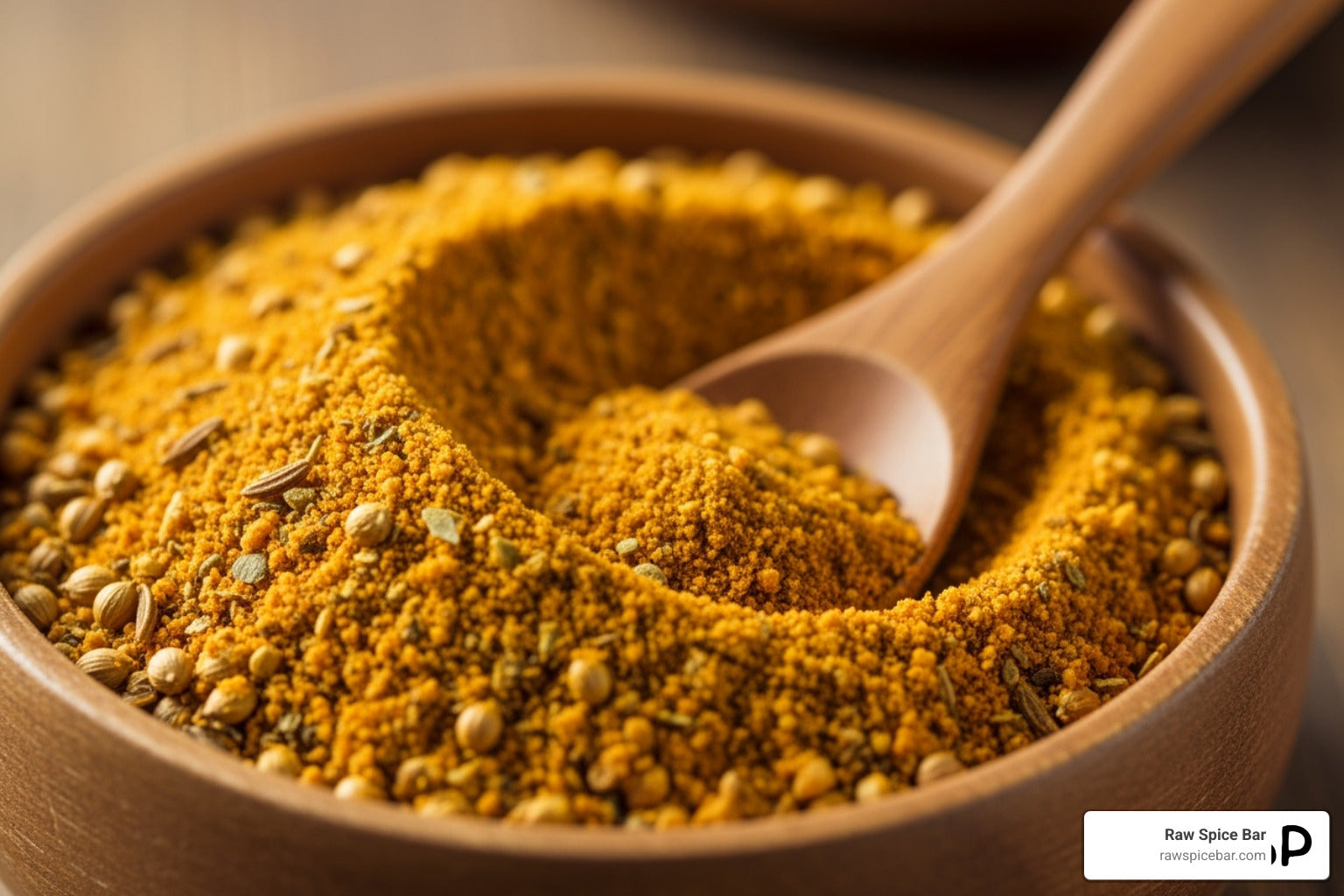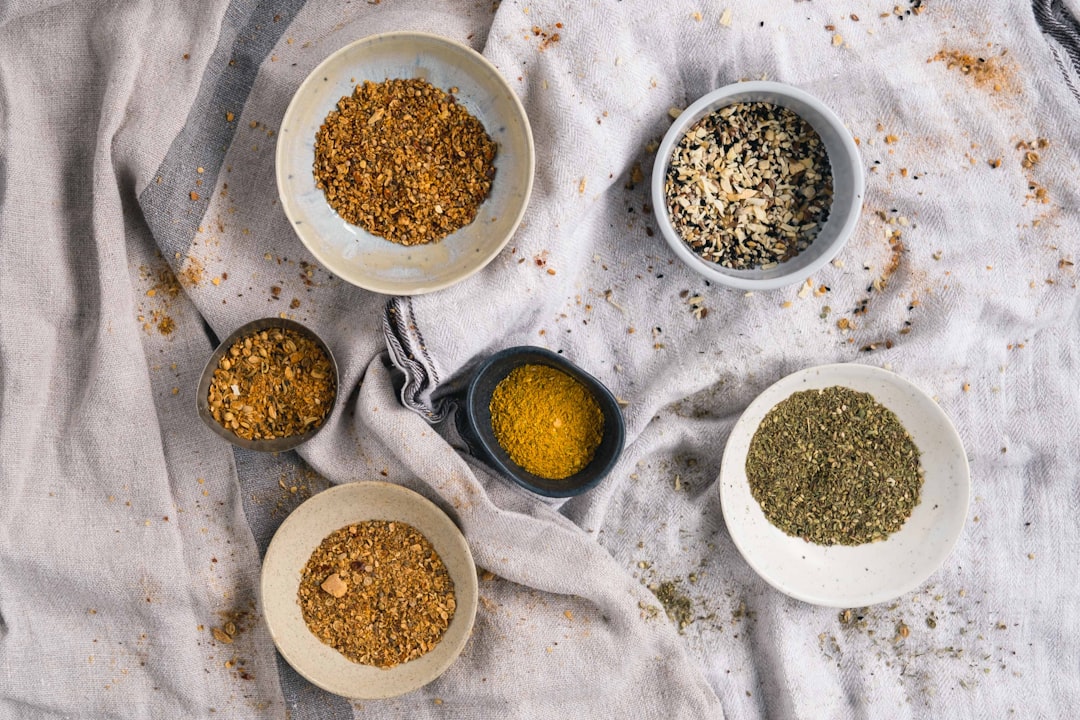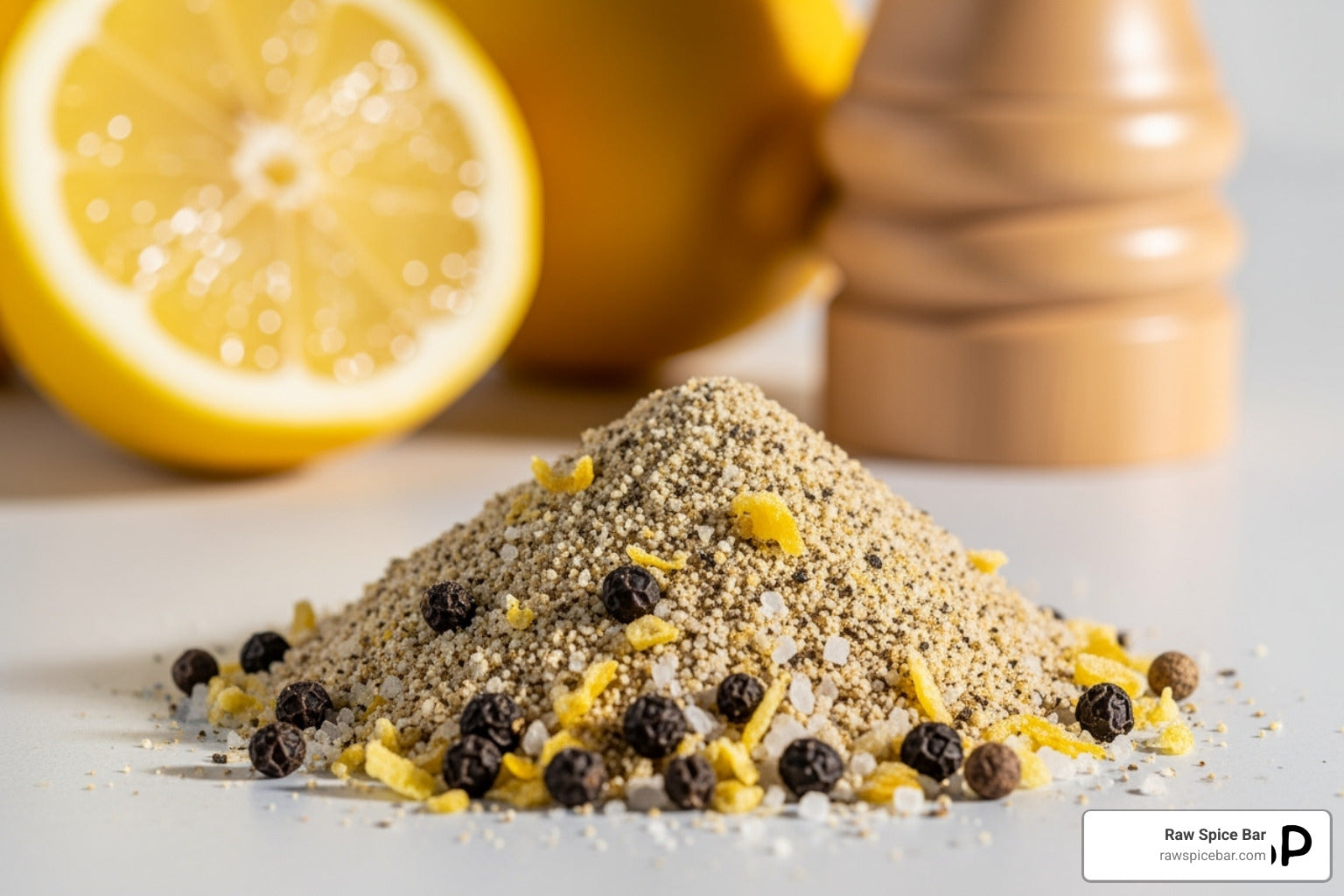Turning great culinary ideas into reality can start in your very own kitchen, especially when it comes to crafting flavorful oils.
Infusing oils with herbs and spices is a simple yet effective way to make your meals more exciting and delicious. Imagine infusing a bit of rosemary into your oil to elevate a fresh salad or adding cumin for a richer depth to roasted veggies.
At Raw Spice Bar, we’re all about bringing the freshest and most vibrant spice blends to your kitchen. Our global spice subscription allows you to try new flavors each month, making every cooking experience unique. With the right herbs and spices, you can create oils that transform your dishes from ordinary to extraordinary.
Whether you’re looking to marinate meats, dress a salad, or sauté your vegetables, infused oils can add that extra kick to your meals. With our carefully crafted spice blends, you'll have everything you need to enhance your cooking and surprise your taste buds.
In this blog, you will learn:
-
The basics of infusing oils with herbs and spices
-
How to choose the right carrier oils and spices for your infusions
-
The best methods and tips for making flavorful oils at home
Let’s dive in!
Understanding Oil Infusions
Oil infusions allow you to capture the rich flavors of herbs and spices in carrier oils, creating a versatile ingredient for your kitchen. You'll explore the basics, benefits, and how to choose the right carrier oils for your infusions.
The Basics of Oil Infusion
Creating an infused oil starts with selecting high-quality herbs and spices.
You can use fresh or dried ingredients like rosemary, basil, garlic, or chili peppers. Clean and dry them thoroughly before use to prevent spoilage.
Next, choose a suitable method: cold infusion or heat infusion.
Cold infusion involves steeping herbs in oil at room temperature, while heat infusion uses gentle warmth to speed up the process. To maintain the oil's purity, ensure all equipment is sterile.
Benefits of Infusing Oils
Infused oils can enhance dishes by adding depth and complexity without extra salt or artificial additives. They provide a concentrated burst of flavor that elevates meals.
These oils can be used in various ways, including dressings, marinades, and sautéing.
Infusing oils at home lets you tailor flavors to your liking and dietary preferences, using trusted ingredients.
Choosing the Right Carrier Oils
When selecting a carrier oil, consider its flavor profile and smoke point.
With its rich taste and moderate smoke point, olive oil is a popular choice for herb infusions such as basil or oregano. For mild flavors, consider using canola or grapeseed oil.
Ensure the oil complements the herbs and spices you use.
Balance is key; the oil should not overpower the infused flavors.
Selecting Herbs and Spices
Choosing the right herbs and spices is key to creating flavorful infused oils. Consider the freshness of your ingredients and the specific flavors you wish to achieve.
Popular Herbs and Spices for Infusion
Infusing oils is an art, and the right choice of ingredients makes all the difference.
Some popular choices include rosemary, thyme, and basil, known for their strong, aromatic flavors. Garlic and chili peppers add a spicy kick, while citrus peels introduce a fresh, zesty note.
For a more exotic twist, you might consider ginger or lemongrass. These ingredients offer diverse flavor profiles that can suit various culinary applications.
Herbs like lavender and mint can also be used for unique and soothing infusions.
Fresh vs. Dried Herbs and Spices
Deciding between fresh and dried herbs and spices affects the outcome of your infused oil.
-
Fresh herbs offer vibrant flavors, but due to their moisture content, they can also shorten the shelf life of oil.
-
On the other hand, dried herbs have a concentrated flavor and are less likely to cause spoilage. This makes them a practical choice for infusion if you want longer-lasting oils.
When using dried ingredients, you typically need less than fresh ones. For instance, substituting one teaspoon of dried herbs can replace a tablespoon of fresh herbs. This ratio ensures the flavor intensity remains balanced.
Preparing Herbs and Spices for Infusion
Proper preparation enhances the flavors of your infused oil.
-
Begin by thoroughly washing fresh herbs to remove any dirt or pesticides. They should then be dried completely to prevent mold from developing in the oil. You can do this by patting them with a towel or air-drying them.
-
For dried ingredients, a simple light roasting or toasting can release essential oils and enhance flavor. Crushing herbs slightly before adding them to oil can also intensify the infusion.
Methods of Infusing Oils
Infusing oils with herbs and spices is a rewarding way to enhance flavors in your cooking. You'll explore three methods: cold, hot, and solar infusions. These techniques vary in time and heat application, offering different benefits and results.
Cold Infusion Technique
The cold-infusion technique does not require heat, making it simple and effective for delicate herbs.
-
Place dried herbs and spices in a clean, dry jar.
-
Fill the jar with oil, ensuring the herbs are fully submerged.
-
Securely seal the jar with a lid.
-
Store it in a cool, dark place for several weeks, shaking it a few times weekly to encourage flavor release.
-
After the infusion, strain the herbs using a fine mesh sieve or cheesecloth.
This method is ideal for preserving oils' fresh taste and aroma, particularly when using herbs like basil or parsley. It's also a great choice if you want to maintain the oil's nutritional profile. Enjoy the subtle, nuanced oil flavors by drizzling them over salads or using them in dressings.
Hot Infusion Technique
The hot infusion technique is quicker and uses heat to speed up the flavor transfer.
-
Begin by gently heating oil in a saucepan over low heat.
-
Once warm, add dried herbs and spices.
-
Important: do not let the oil boil, as too much heat can damage the flavors.
-
Simmer the mixture briefly, typically 5-10 minutes, then remove from heat. Allow the oil to cool completely before straining out the herbs.
This method works well with hearty spices, like rosemary or oregano, that release their flavors more readily with heat. Hot infusion is perfect when you're short on time and need infused oil quickly. Use the oil for roasting veggies or marinating meats for a robust, savory flavor.
Solar Infusion Method
For those who enjoy a natural process, the solar infusion method uses sunlight to extract flavors.
-
Place dried herbs and spices in an oil-filled glass jar.
-
Seal it tightly and leave it in a sunny spot, like a windowsill, for several weeks.
-
The gentle, slow heat from the sun enhances the flavor extraction without using artificial heat sources.
Solar infusion is well-suited for herbs like thyme and lavender, adding a unique touch to your dishes.
Safety and Storage
Infusing oils with herbs and spices can enhance your dishes, adding unique flavors and aromas. However, to ensure your infused oils are delicious and safe to consume, you must address safety, proper storage, and shelf life.
Ensuring Infusion Safety
Safety is crucial for infusing oils at home.
-
Start by using fresh, thoroughly washed herbs and spices.
-
Dry them completely because moisture can lead to bacterial growth. Dried herbs and spices are another safe option.
-
Sterilize the jars you use. To effectively sterilize them, boil them in water for about 10 minutes. This step reduces the risk of contamination.
-
Fill containers with oil to submerge herbs completely, avoiding exposure to air that can spoil the oil. Consider using a high-quality oil with a stable shelf life, like olive oil.
-
Store infused oils in the fridge to keep them safe and fresh. Use them within a month to prevent spoilage or rancidity.
Following these steps can help you create tasty, safe-infused oils for your kitchen.
Best Practices for Storage
Proper storage extends the life of your infused oils and keeps them tasting their best.
-
Use dark glass bottles to protect the oil from light, which can degrade its quality over time. If dark bottles aren’t available, store the oils in dark places, like a cabinet.
-
Keep infused oils away from heat sources. Too much heat can speed up the spoiling process. Kitchen counters near stoves can be a poor choice as temperatures fluctuate. Instead, opt for a cool, stable environment.
-
Label your oils with the date of preparation. This simple step reminds you to use them promptly.
-
For ongoing use, consider small batches that you can consume quickly.
Shelf Life of Infused Oils
The shelf life depends on how you prepare them and the storage conditions.
Infused oils can last about a month under ideal storage conditions. Always inspect the oil for any off smells or flavors before use. If anything seems off, it’s best to discard the oil.
Refrigerating the oils can slow the growth of bacteria, extending their shelf life. While storing in the freezer is an option, it may affect the texture, so use it mainly for long-term storage if necessary.
Creative Uses of Infused Oils
Infused oils can enhance culinary experiences, enrich skincare routines, and elevate relaxation practices. You can tailor the flavors and scents to suit your tastes and needs by making your own.
Culinary Applications
Infused oils add depth and flavor to your cooking.
-
You can drizzle a basil-infused oil over a fresh Caprese salad or use rosemary-infused oil to flavor roasted potatoes. These oils also work well for sautéing vegetables or as a base for salad dressings.
-
For a unique twist, try an oil infused with herbs de Provence for a touch of French flair. Enhance pizzas, pasta, and even toasted bread to create simple yet delicious dishes.
-
For a spicy kick, experiment with different combinations, like garlic and chili. These oils are versatile and can turn any meal into a gourmet experience, making everyday dishes feel special.
Cosmetic and Skincare Products
Infused oils are perfect for DIY skincare products.
You can create a soothing lavender-infused oil to use as a natural moisturizer. Simply apply a few drops to damp skin after a shower.
Combine chamomile and calendula-infused oils for a gentle face serum. These oils provide nourishment and help calm irritated skin. Using oils infused with herbs can provide antioxidant benefits and enhance the overall health of your skin.
A rosemary-infused oil can promote scalp health and add shine to hair care. Massage it into your scalp before washing it to rejuvenate your hair naturally.
Aromatherapy and Massage
Use infused oils as a calming element in your aromatherapy routine.
A mix of eucalyptus and peppermint can help clear your mind and invigorate your senses. Lavender-infused oil is ideal for relaxation.
In massage therapy, infused oils provide a soothing experience. Mix your favorite herbs and spices to create a personalized massage oil. This enhances the therapeutic benefits of the massage and leaves your skin feeling smooth.
For the ultimate relaxation, combine infused oils with your bath. Add a few drops of warm water to fill the room with calming scents, enhancing stress relief and relaxation.
Troubleshooting Common Issues
You may face issues like cloudiness, unexpected odors, or spoilage when infusing oils with herbs and spices. Understanding and how to address these problems can help you create flavorful and clear-infused oils.
Addressing Cloudiness or Sediment
Cloudiness or sediment in infused oils can be due to moisture from fresh herbs or spices.
To prevent this, always thoroughly dry your herbs before adding them to the oil. You can also strain the oil after infusion using a fine-mesh sieve or cheesecloth, which helps remove small particles.
If cloudiness persists, check the storage conditions. To maintain clarity, keep infused oils in a cool, dark place. If sediment forms over time, strain the oil again.
Managing Unexpected Odors
If the oils or herbs are not fresh, unpleasant smells might develop.
Always start with high-quality herbs and spices. Check the oil for rancidity, as old or improperly stored oils can produce off-putting odors. Store infused oils in airtight containers to prevent contamination from other odors in the environment.
Using oils like olive oil, which has a mild scent, can help highlight the aromas of the infused herbs and spices.
Preventing Spoilage
Spoilage occurs when bacteria grow in the infused oil, often due to moisture.
Use dried herbs to reduce the risk of spoilage. If using fresh herbs, blanch them quickly to remove excess moisture, then dry them thoroughly. Proper storage is crucial. Store oils in sterilized, airtight containers in the refrigerator to extend their freshness.
Keeping infused oils cool limits bacterial growth and prolongs their shelf life.
Frequently Asked Questions
Infusing oils with herbs and spices enhances flavors and creates natural remedies. Below are answers to some common questions about making these at home.
How can I safely prepare herb-infused oils at home?
To safely prepare herb-infused oils, start with clean, dry herbs and a sterilized jar. To prevent spoilage, use a carrier oil like olive or sunflower oil. Store your infused oil in a cool, dark place.
What is the proper technique for infusing oil with herbs using a stovetop method?
The stovetop method involves gently heating the oil with herbs on low heat. Avoid simmering or boiling. This helps release flavors without damaging the herbs. Strain the oil through a fine mesh before storage.
Which herbs are most effective for creating infused oils that promote skin health?
Lavender, chamomile, and calendula are popular choices for skin health. These herbs have soothing and healing properties.
Can you provide guidance on creating herb-infused oils to enhance hair growth?
For hair growth, use herbs like rosemary and peppermint. These improve scalp circulation and nourish hair. Combine with a carrier oil and massage into the scalp regularly.
What are the best practices for choosing a carrier oil when infusing with herbs?
Choose a carrier oil based on its properties and your needs. Olive oil is nourishing, while grapeseed oil is lightweight. Consider scent, shelf life, and skin compatibility.
How long can I expect homemade herb-infused oils to maintain their potency and safety?
Homemade infused oils can be stored for up to six months. They should be kept in a cool, dark place to maintain potency and prevent spoilage.




